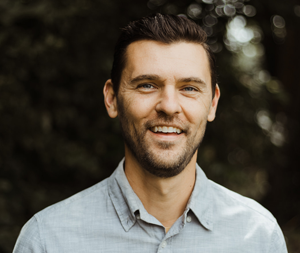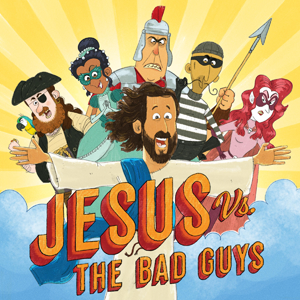 |
Dr Jared Neusch, author of Jesus vs the Bad Guys: A Story of Love and Forgiveness, explores ways to explore stories of violence and non-violence with young people |
From the earliest age, children will be exposed to the basic concept of the battle of good vs evil. Whether it’s a group of Avengers in a cosmic conflict against alien-like beings, or a pack of brave pups thwarting the efforts of a pesky mayor in a top hat, kids will pick up on this fundamental notion. What often makes these stories exciting to follow is how exactly the protagonist overcomes evil. Will punches and kicks do the job? Maybe there’s a trap door?
A child’s awareness that a battle of good vs evil exists in the world is inevitable. As leaders, parents, and carers of children, the critical part is not to try and shield them from this, but explore with them how evil is overcome. To do this well, we must then ask: What does God show us about how evil is overcome?
How does God overcome evil?
While, in a certain sense, this question is fairly straightforward, the biblical path toward an answer appears as anything but that. In the first few pages of the biblical narrative we read that, in response to growing violence, God spares a single family and proceeds to drown the rest of humankind (men, women, children, and babies). However, in the Sermon on the Mount, Jesus commands his listeners to love their enemies because this is what their Father in heaven does. His evidence? Simply observe how God kindly and graciously uses the rain and the sun to love his enemies (Mt 5:45).
Several chapters after the flood in Genesis, God moves on from water and destroys Sodom and Gomorrah through issuing ‘sulfur and fire … out of heaven’ (Gen 19:24). Yet, when Jesus’ disciples inquire about commanding ‘fire to come down from heaven and consume’ an inhospitable Samaritan village, they are met with a firm rebuke (Lk 9:54-55).
In 2 Samuel, an Israelite named Uzzah had the privilege of driving the cart that held the ark of God. Things took a turn for the worse however, when, as the oxen stumbled, Uzzah reached out to steady the ark, and God struck him dead (2 Sam 6:7). Returning to the Sermon on the Mount, Jesus tells the crowd what to do when someone reaches out and strikes their right cheek. His instruction was no less than what he, the Son of God, would do in his final hours before the cross: ‘turn the other also’ (Mt 5:39).
So, what do we do with such apparently disparate divine approaches to evil? How can we begin to interpret global atrocities like natural disasters, wars, and genocides? Might these be divine? How do we face evil systems, inhospitable people, and those who would reach out a hand against us and others? To act with confidence toward evil, we need clarity on God and God’s approach to evil.
Jesus as our example
Thanks be to God that he chose to reveal his nature in the clearest way possible for humans: putting on human flesh. In the beginning of John’s gospel, he tells us something quite critical. Moses has given us the law, but it is through Jesus that we receive grace and truth. What truth does Jesus provide us with? ‘It is the only Son, himself God, who is close to the Father’s heart, who has made him known’ (Jn 1:18). Jesus shows us the truth about the Father’s heart.
Similarly, the author of Hebrews begins their letter by writing that God has spoken through various mediums over time. But now, God speaks with absolute clarity through His Son. As opposed to what was communicated through the ‘ancestors’ and ‘prophets,’ it is Jesus that ‘is the reflection of God’s glory and the exact imprint of God’s very being’ (Hebrews 1:1-3).
In short, we have many different stories about God, His ways in the world, and how He approaches evil. It is Jesus, however, that provides us with absolute clarity.
The life and teachings of Jesus — most climactically the cross and resurrection — instruct us in our methods of facing and overcoming evil. We know that the events of Easter trigger the undoing of evil and death. We do children a devastating disservice then, if these events are framed solely as ‘this is how Jesus provides you with salvation.’ While yes, this is the case (hallelujah!), we then discover, for example, from Paul that we participate in the crucifixion and resurrection. The New Testament message is less one of substitution, and instead inclusion. Jesus himself tells us to take up our crosses. And so, as we educate children about the cross and resurrection as more than our deliverance, but also an invitation and our ethical guide, we are providing them with the tools at a very early age to begin to wonder: Is this superhero in story X or Y overcoming evil in a good way?
Tips to guide this process
As mentioned at the beginning, don’t attempt to shield children from all violent/non-loving depictions of ‘good’ vs ‘evil.’ This is a losing and unnecessary battle. Instead, be a curious conversation partner with kids, and ask good questions about these stories.
- Emphasise the humanity of all people. ‘I wonder what their story is, why they’re making these choices, and what their name might be?’
- Pray not just for friends, family, and people in our ‘clan.’ But also for people we might consider enemies — whether it be a bully at school or the leader of a country.
- Brainstorm with children kind gestures towards difficult people. How does it change the relational dynamic to issue a compliment, or give a small, unexpected gift?
- Allow children to see you lead the way on these things. How are you as a leader or parent demonstrating these principles?
Taking it further
 |
My good friend, Connor Shram, and I have written Jesus vs. the Bad Guys: A Story of Love and Forgiveness (Tyndale, 2024), a kids' book that invites children into a playful and imaginative journey of asking the question: ‘How does Jesus face the bad guys?’.
- Does he ride in on a T-rex?
- Does he blast them with fart canons?
- Does he have a different secret weapon?
|
 |
If you’d like weekly bite-sized encouragement on peace-making and parenting, you can sign up for our newsletter “The Peaceful Parents Club” at jesusisforkids.com |
Dr Jared Neusch works at St Mellitus College, London and has interests in the apocalyptic readings of Paul, hermeneutics and Christian pacifism.
Not a Roots subscriber?
